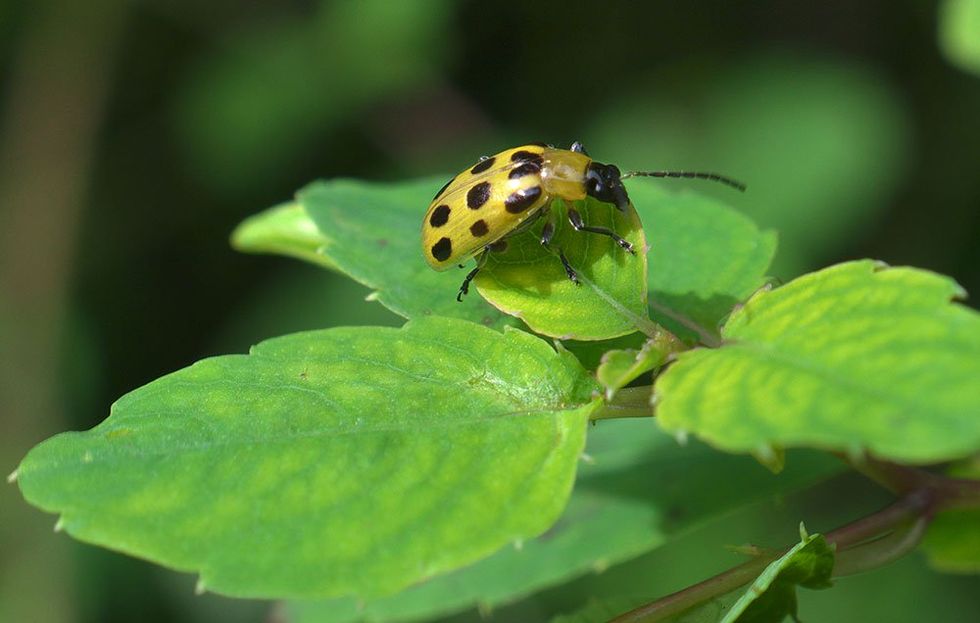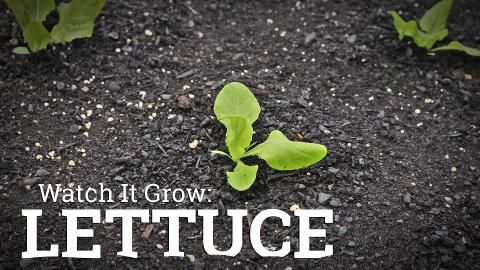You know you might have a cucumber beetle problem if your plant leaves are yellowing, wilting, or have holes appearing on them, or if your seedling stems are being chomped on.
(Whether you're starting your first garden or switching to organic, Rodale’s Basic Organic Gardening has all the answers and advice you need—get your copy today.)
The beetles swarm on seedlings, feeding on leaves and young shoots, often killing plants; they also attack stems and flowers of older plants and eat holes in fruit. Their feeding can transmit wilt and mosaic viruses to your plants. The beetles can be found across North America, mostly in the West.
Related: Everything You Need To Know About Growing Crisp Cucumbers
There are two types of pesky cucumber beetles: striped and spotted. Striped cucumber beetles mostly feed on circubit vegetables vegetables like cucumbers, squash, pumpkins, and beans, and rarely on other plants, while the similar spotted cucumber beetles feed on over 200 different crop and non-crop plants. They are both yellow, and and you can differentiate them by the shape of the black marks on their wing covers. Striped cucumber beetle adults are yellow, elongate, 1/4-inch beetles with black heads and three wide black stripes on wing covers (as opposed to the spots on the spotted beetle's wing covers). Striped cucumber beetles lay eggs at the base of cucurbit plants and their larvae then feed on the roots of these plants. The adults feed on squash family plants, beans, corn, peas, and blossoms of many garden plants. Larvae feed on roots of squash family plants only, killing or stunting plants.
Related: 81 Border Plants That Are Better Than A Fence
Life cycle of the cucumber beetle
Adults overwinter in dense grass or under leaves (so get rid of these right away to prevent a cucumber beetle infestation!), emerging in early spring to early summer. They eat weed pollen for 2 weeks, then move to crop plants, laying eggs in soil at base of plants. Eggs hatch in 10 days; larvae burrow into soil, feed on roots for 2 to 6 weeks, pupate in mid- to late summer. The larvae are slender, white grubs.
Adults typically emerge in 2 weeks to feed on blossoms and maturing fruit, with one to two generations per year. The spotted cucumber beetle is a bitdifferent, primarily laying its eggs on corn and other grasses such that the larvae of spotted cucumber beetles are not damaging to cucurbit crops.
Related: 14 Insects You Actually Want To Have In Your Garden
How to control cucumber beetles naturally
There are several strategies you can use if you spot cucumber beetles popping up in your garden. The first thing you can do to prevent them is to remove any dense grass, leaves, garden trash and other debris shortly after harvest to reduce their potential overwintering sites. The best course of action once you spot them should be to inspect plants frequently for these beetles and handpick or vaccum any that are discovered and remove them.
Another step can be to introduce a natural predator. Commercially available beneficial insects, such as ladybugs, green lacewing and the spined soldier bug, will feed on pest eggs. (Here are 10 beneficial insects you actually want to have in your garden.) Beneficial nematodes also work well to curtail immature stages developing in the soil.
Remove and destroy crop residues where adults overwinter; cover seedlings or plants with a floating row cover, and hand-pollinate covered squash family plants. You can also pile deep straw mulch around plants to discourage beetles from moving between plants. For uncovered plants, you can apply kaolin clay, especially to leaf undersides, and reapply after rain. The clay is a good natural mineral deterrent.














